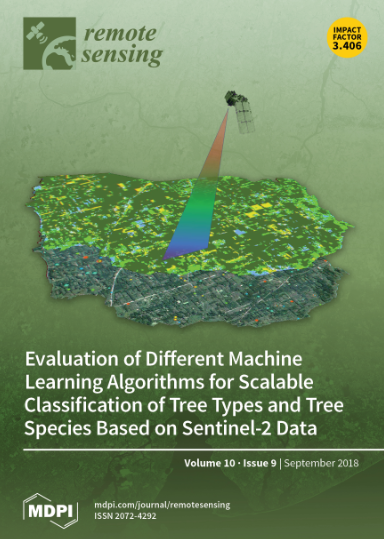加强紫花苜蓿生物量预测:利用遥感数据的创新框架
IF 4.2
2区 地球科学
Q2 ENVIRONMENTAL SCIENCES
引用次数: 0
摘要
利用卫星数据估算牧草生物量已成为一种很有前途的方法,可帮助农民确定最佳割草时间,从而最大限度地提高生物量产量。本研究旨在开发一个创新框架,整合田间数据和卫星数据,以估算农场规模的紫花苜蓿(Medicago sativa L.)地上生物量。为此,研究人员在美国堪萨斯州三块田地的不同刈割日期收集了 2022 年整个生长季节的样本。采用的卫星数据有四个来源:哨兵-2、PlanetScope、Planet Fusion 和生物量代理。创建了一个超参数网格,以建立不同的组合并选择最佳系数。排列特征重要性技术显示,PlanetScope 的近红外波段和生物量代理产品是对生物量预测模型贡献最大的预测特征。应用贝叶斯加性回归树(BART)来探索其建立预测模型的能力。其性能通过统计指标进行评估(r2:0.61;RMSE:0.29 kg.m-2)。此外,该框架还提出了不确定性量化方法,以评估预测的误差范围。总之,这种非参数方法的整合提供了一种有用的预测工具,具有优化农民管理决策的潜力。本文章由计算机程序翻译,如有差异,请以英文原文为准。
Enhancing Alfalfa Biomass Prediction: An Innovative Framework Using Remote Sensing Data
Estimating pasture biomass has emerged as a promising avenue to assist farmers in identifying the best cutting times for maximizing biomass yield using satellite data. This study aims to develop an innovative framework integrating field and satellite data to estimate aboveground biomass in alfalfa (Medicago sativa L.) at farm scale. For this purpose, samples were collected throughout the 2022 growing season on different mowing dates at three fields in Kansas, USA. The satellite data employed comprised four sources: Sentinel-2, PlanetScope, Planet Fusion, and Biomass Proxy. A grid of hyperparameters was created to establish different combinations and select the best coefficients. The permutation feature importance technique revealed that the Planet’s PlanetScope near-infrared (NIR) band and the Biomass Proxy product were the predictive features with the highest contribution to the biomass prediction model’s. A Bayesian Additive Regression Tree (BART) was applied to explore its ability to build a predictive model. Its performance was assessed via statistical metrics (r2: 0.61; RMSE: 0.29 kg.m−2). Additionally, uncertainty quantifications were proposed with this framework to assess the range of error in the predictions. In conclusion, this integration in a nonparametric approach achieved a useful predicting tool with the potential to optimize farmers’ management decisions.
求助全文
通过发布文献求助,成功后即可免费获取论文全文。
去求助
来源期刊

Remote Sensing
REMOTE SENSING-
CiteScore
8.30
自引率
24.00%
发文量
5435
审稿时长
20.66 days
期刊介绍:
Remote Sensing (ISSN 2072-4292) publishes regular research papers, reviews, letters and communications covering all aspects of the remote sensing process, from instrument design and signal processing to the retrieval of geophysical parameters and their application in geosciences. Our aim is to encourage scientists to publish experimental, theoretical and computational results in as much detail as possible so that results can be easily reproduced. There is no restriction on the length of the papers. The full experimental details must be provided so that the results can be reproduced.
 求助内容:
求助内容: 应助结果提醒方式:
应助结果提醒方式:


